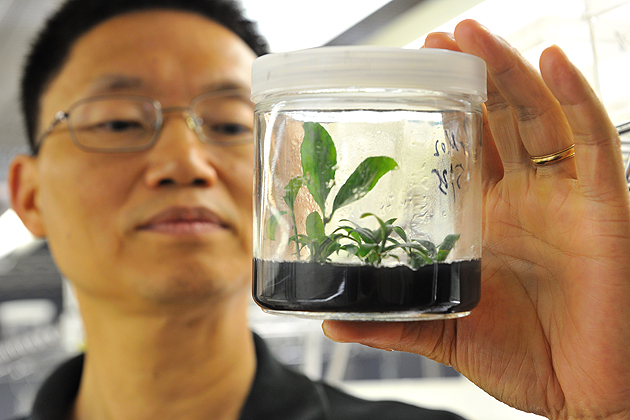
Professor Yi Li’s laboratory in the University of Connecticut’s College of Agriculture and Natural Resources has developed a seedless variety of the popular ornamental shrub Euonymus alatus, also called ‘burning bush,’ that retains the plant’s brilliant foliage yet eliminates its ability to spread and invade natural habitats.
“The availability of a triploid seedless, non-invasive variety of burning bush creates a win-win situation for both consumers and commercial nurseries,” says Li, head of UConn’s Transgenic Plant Facility and director of the New England Invasive Plant Center at the Storrs campus. “The bush is an extremely popular ornamental plant for landscapers and gardeners because of its intense red autumn foliage and robust ability to grow in a wide range of soils and environmental conditions. In addition, the plant has very few pest or disease problems.”
Also known as ‘winged euonymus’ because of its distinctive winged branches, burning bush is a top cash crop for the $16 billion ornamental plant industry. It is especially popular in New England and along the eastern seaboard, where the shrub is used for foundation plantings, hedges, and along highways and commercial strips.
National sales of burning bush top tens of millions of dollars each year. The plant, however, spreads aggressively and has been listed as an invasive species in 21 states. It has already been banned in Massachusetts and New Hampshire, and is on an invasive plant ‘watch list’ in many other states, including Connecticut.
The economic cost of invasive plants is estimated at more than $40 billion per year in the U.S.

The creation of a non-invasive variety of burning bush should help restore the shrub’s prominence in the commercial marketplace.
“This is a big win for everyone,” says Bob Heffernan, executive director of the Connecticut Green Industries Council. “We get to keep selling a popular plant, the public gets to keep using it in their landscapes, and the environment is safe from invasives.”
Professor Max Cheng, a horticultural plant biotechnologist at the University of Tennessee-Knoxville, says Li’s success in regenerating a triploid non-invasive burning bush “has great economic and environmental significance.”
“Several universities and laboratories in the U.S. have been working on developing triploid or sterile burning bush for years,” says Cheng. “Endosperm cells of angiosperms are naturally triploid, but regeneration from endosperm cells, particularly from endosperms of woody species, is often very difficult. Dr. Li’s success represents a major breakthrough in developing sterile, non-invasive Euonymus alatus, which is of great importance to the American ornamental horticulture industry and gardeners.”
Mark Sellew, the owner of Prides Corner Farms of Lebanon, Conn., one of the largest wholesale nurseries in the eastern U.S., also praised UConn’s success in developing a sterile variety of burning bush.
“This sterile cultivar of burning bush could not come soon enough,” says Sellew. “This plant is a very important part of my business. We love working with UConn. I think this shows how very important it is for industry and academia to work together.”
Burning bush’s invasive characteristics stem from its prodigious seed production. The plant produces tens of thousands of seeds that are transported by rainwater and birds to other sites, especially open woodlands, where they create dense thickets that displace native vegetation. The plant’s root system forms a tight mat below the soil surface and its broad profile (it averages 6 to 9 feet in height and is capable of reaching 15 feet) creates heavy shade that threatens the survival of plants living beneath it.
Native to eastern Asia, the deciduous Euonymus alatus was introduced in the United States around 1860. The shrub’s natural ornamental features have been genetically improved over time, giving rise to its widespread popularity. It can be found in the eastern United States from New England to Florida, and as far west as Illinois.
Recognizing the plant’s popularity among consumers and its economic importance to the ornamental plant and landscape industries, Li obtained a grant from the U.S. Department of Agriculture in 2003 to work on the development of a non-invasive variety of burning bush. The New England Invasive Plant Center has provided additional funding for the research since 2006. The invasive plant center was made possible through the support of Connecticut Rep. Rosa DeLauro (D-3rd District). DeLauro helped secure federal funding to launch the center, which aims to develop strategies and methods to address invasive plant problems.

The new lines of sterile non-invasive burning bush plant—which were derived from a popular dwarf variety known as (E. alatus) ‘Compactus’—took years to develop. Members of Li’s research team, Chandra Thammina, Mingyang He, Litang Lu, and others, painstakingly removed thousands of immature and mature endosperm from deep inside the plant’s seeds under sterile conditions and then treated them with special plant growth regulators. The team carefully maintained endosperm tissue explants in Petri dishes so that a callus, bud, seedling, and ultimately a new triploid seedless variety were grown.
“Finding the right combination of plant growth regulators and repeatedly testing and re-testing the process to validate its success was a lengthy, yet ultimately rewarding, process,” Li says.
The process to produce triploid plants from endosperm tissues is so difficult that since endosperm regeneration of plants was first reported in the early 1950s, it has been successful in only 32 plant species. Li praises his research team’s persistence, dedication, and passion, which, he says, carried his staff through the long hours necessary for separating thousands of mature and immature endosperms once the plants went to seed in the fall.
The research report appears in the August 2011 issue of HortScience, an international journal serving horticulture scientists and the horticulture industry.
The research team reports that it successfully produced 12 independently regenerated triploid plants of burning bush. Triploid plants are sterile due to uneven chromosome division as cells multiply. Li is working with UConn’s Office of Technology Commercialization to patent the process used to regenerate the burning bush triploid and ultimately bring the new plant variety to the commercial horticulture industry.



